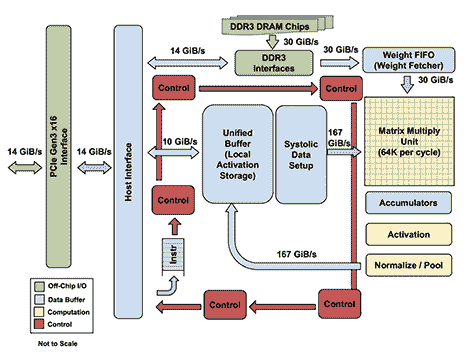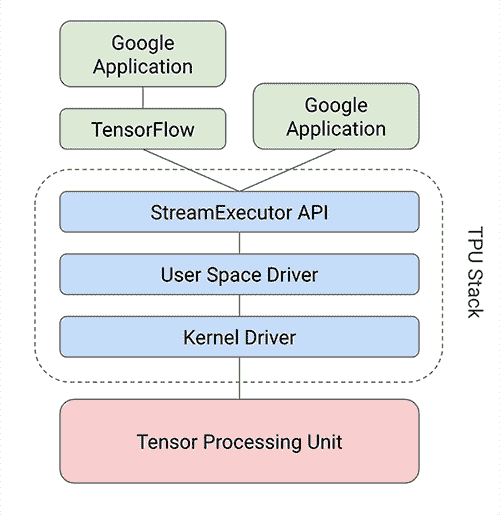# 十九、張量處理單元
**張量處理單元**(**TPU**)是**專用集成電路**(**ASIC**),它實現了針對計算要求而優化的硬件電路深度神經網絡。 TPU 基于**復雜指令集計算機**(**CISC**)指令集,該指令集實現用于訓練深度神經網絡的復雜任務的高級指令。 TPU 架構的核心在于優化矩陣運算的脈動數組。
The Architecture of TPUImage from:?https://cloud.google.com/blog/big-data/2017/05/images/149454602921110/tpu-15.png
TensorFlow 提供了一個編譯器和軟件棧,可將 API 調用從 TensorFlow 圖轉換為 TPU 指令。以下框圖描述了在 TPU 棧頂部運行的 TensorFlow 模型的架構:

圖像來自[這個鏈接](https://cloud.google.com/blog/big-data/2017/05/images/149454602921110/tpu-2.png)。TPU 架構的更多信息,閱讀[博客](https://cloud.google.com/blog/big-data/2017/05/an-in-depth-look-at-googles-first-tensor-processing-unit-tpu)。
TPU 的 TensorFlow API 位于`tf.contrib.tpu`模塊中。為了在 TPU 上構建模型,使用以下三個 TPU 特定的 TensorFlow 模塊:
* `tpu_config`:`tpu_config`模塊允許您創建配置對象,其中包含有關將運行模型的主機的信息。
* `tpu_estimator`:`tpu_estimator`模塊將估計器封裝在`TPUEstimatorSpec`類中。要在 TPU 上運行估計器,我們創建此類的對象。
* `tpu_optimizer`:`tpu_optimizer`模塊包裝優化器。例如,在下面的示例代碼中,我們將`tpu_optimizer`類中的 SGD 優化器包裝在`tpu_optimizer`類中。
例如,以下代碼使用 TFEstimator API 為 TPU 上的 MNIST 數據集構建 CNN 模型:
以下代碼改編自[這個頁面](https://github.com/tensorflow/tpu-demos/blob/master/cloud_tpu/models/mnist/mnist.py)。
```py
import tensorflow as tf
from tensorflow.contrib.tpu.python.tpu import tpu_config
from tensorflow.contrib.tpu.python.tpu import tpu_estimator
from tensorflow.contrib.tpu.python.tpu import tpu_optimizer
learning_rate = 0.01
batch_size = 128
def metric_fn(labels, logits):
predictions = tf.argmax(logits, 1)
return {
"accuracy": tf.metrics.precision(
labels=labels, predictions=predictions),
}
def model_fn(features, labels, mode):
if mode == tf.estimator.ModeKeys.PREDICT:
raise RuntimeError("mode {} is not supported yet".format(mode))
input_layer = tf.reshape(features, [-1, 28, 28, 1])
conv1 = tf.layers.conv2d(
inputs=input_layer,
filters=32,
kernel_size=[5, 5],
padding="same",
activation=tf.nn.relu)
pool1 = tf.layers.max_pooling2d(inputs=conv1, pool_size=[2, 2],
strides=2)
conv2 = tf.layers.conv2d(
inputs=pool1,
filters=64,
kernel_size=[5, 5],
padding="same",
activation=tf.nn.relu)
pool2 = tf.layers.max_pooling2d(inputs=conv2, pool_size=[2, 2],
strides=2)
pool2_flat = tf.reshape(pool2, [-1, 7 * 7 * 64])
dense = tf.layers.dense(inputs=pool2_flat, units=128,
activation=tf.nn.relu)
dropout = tf.layers.dropout(
inputs=dense, rate=0.4,
training=mode == tf.estimator.ModeKeys.TRAIN)
logits = tf.layers.dense(inputs=dropout, units=10)
onehot_labels = tf.one_hot(indices=tf.cast(labels, tf.int32), depth=10)
loss = tf.losses.softmax_cross_entropy(
onehot_labels=onehot_labels, logits=logits)
if mode == tf.estimator.ModeKeys.EVAL:
return tpu_estimator.TPUEstimatorSpec(
mode=mode,
loss=loss,
eval_metrics=(metric_fn, [labels, logits]))
# Train.
decaying_learning_rate = tf.train.exponential_decay(learning_rate,
tf.train.get_global_step(),
100000,0.96)
optimizer = tpu_optimizer.CrossShardOptimizer(
tf.train.GradientDescentOptimizer(
learning_rate=decaying_learning_rate))
train_op = optimizer.minimize(loss,
global_step=tf.train.get_global_step())
return tpu_estimator.TPUEstimatorSpec(mode=mode,
loss=loss, train_op=train_op)
def get_input_fn(filename):
def input_fn(params):
batch_size = params["batch_size"]
def parser(serialized_example):
features = tf.parse_single_example(
serialized_example,
features={
"image_raw": tf.FixedLenFeature([], tf.string),
"label": tf.FixedLenFeature([], tf.int64),
})
image = tf.decode_raw(features["image_raw"], tf.uint8)
image.set_shape([28 * 28])
image = tf.cast(image, tf.float32) * (1\. / 255) - 0.5
label = tf.cast(features["label"], tf.int32)
return image, label
dataset = tf.data.TFRecordDataset(
filename, buffer_size=FLAGS.dataset_reader_buffer_size)
dataset = dataset.map(parser).cache().repeat()
dataset = dataset.apply(
tf.contrib.data.batch_and_drop_remainder(batch_size))
images, labels = dataset.make_one_shot_iterator().get_next()
return images, labels
return input_fn
# TPU config
master = 'local' #URL of the TPU instance
model_dir = '/home/armando/models/mnist'
n_iterations = 50 # number of iterations per TPU training loop
n_shards = 8 # number of TPU chips
run_config = tpu_config.RunConfig(
master=master,
evaluation_master=master,
model_dir=model_dir,
session_config=tf.ConfigProto(
allow_soft_placement=True,
log_device_placement=True
),
tpu_config=tpu_config.TPUConfig(n_iterations,
n_shards
)
)
estimator = tpu_estimator.TPUEstimator(
model_fn=model_fn,
use_tpu=True,
train_batch_size=batch_size,
eval_batch_size=batch_size,
config=run_config)
train_file = '/home/armando/datasets/mnist/train' # input data file
train_steps = 1000 # number of steps to train for
estimator.train(input_fn=get_input_fn(train_file),
max_steps=train_steps
)
eval_file = '/home/armando/datasets/mnist/test' # test data file
eval_steps = 10
estimator.evaluate(input_fn=get_input_fn(eval_file),
steps=eval_steps
)
```
有關在 TPU 上構建模型的更多示例,[請訪問此鏈接](https://github.com/tensorflow/tpu-demos)。
- TensorFlow 1.x 深度學習秘籍
- 零、前言
- 一、TensorFlow 簡介
- 二、回歸
- 三、神經網絡:感知器
- 四、卷積神經網絡
- 五、高級卷積神經網絡
- 六、循環神經網絡
- 七、無監督學習
- 八、自編碼器
- 九、強化學習
- 十、移動計算
- 十一、生成模型和 CapsNet
- 十二、分布式 TensorFlow 和云深度學習
- 十三、AutoML 和學習如何學習(元學習)
- 十四、TensorFlow 處理單元
- 使用 TensorFlow 構建機器學習項目中文版
- 一、探索和轉換數據
- 二、聚類
- 三、線性回歸
- 四、邏輯回歸
- 五、簡單的前饋神經網絡
- 六、卷積神經網絡
- 七、循環神經網絡和 LSTM
- 八、深度神經網絡
- 九、大規模運行模型 -- GPU 和服務
- 十、庫安裝和其他提示
- TensorFlow 深度學習中文第二版
- 一、人工神經網絡
- 二、TensorFlow v1.6 的新功能是什么?
- 三、實現前饋神經網絡
- 四、CNN 實戰
- 五、使用 TensorFlow 實現自編碼器
- 六、RNN 和梯度消失或爆炸問題
- 七、TensorFlow GPU 配置
- 八、TFLearn
- 九、使用協同過濾的電影推薦
- 十、OpenAI Gym
- TensorFlow 深度學習實戰指南中文版
- 一、入門
- 二、深度神經網絡
- 三、卷積神經網絡
- 四、循環神經網絡介紹
- 五、總結
- 精通 TensorFlow 1.x
- 一、TensorFlow 101
- 二、TensorFlow 的高級庫
- 三、Keras 101
- 四、TensorFlow 中的經典機器學習
- 五、TensorFlow 和 Keras 中的神經網絡和 MLP
- 六、TensorFlow 和 Keras 中的 RNN
- 七、TensorFlow 和 Keras 中的用于時間序列數據的 RNN
- 八、TensorFlow 和 Keras 中的用于文本數據的 RNN
- 九、TensorFlow 和 Keras 中的 CNN
- 十、TensorFlow 和 Keras 中的自編碼器
- 十一、TF 服務:生產中的 TensorFlow 模型
- 十二、遷移學習和預訓練模型
- 十三、深度強化學習
- 十四、生成對抗網絡
- 十五、TensorFlow 集群的分布式模型
- 十六、移動和嵌入式平臺上的 TensorFlow 模型
- 十七、R 中的 TensorFlow 和 Keras
- 十八、調試 TensorFlow 模型
- 十九、張量處理單元
- TensorFlow 機器學習秘籍中文第二版
- 一、TensorFlow 入門
- 二、TensorFlow 的方式
- 三、線性回歸
- 四、支持向量機
- 五、最近鄰方法
- 六、神經網絡
- 七、自然語言處理
- 八、卷積神經網絡
- 九、循環神經網絡
- 十、將 TensorFlow 投入生產
- 十一、更多 TensorFlow
- 與 TensorFlow 的初次接觸
- 前言
- 1.?TensorFlow 基礎知識
- 2. TensorFlow 中的線性回歸
- 3. TensorFlow 中的聚類
- 4. TensorFlow 中的單層神經網絡
- 5. TensorFlow 中的多層神經網絡
- 6. 并行
- 后記
- TensorFlow 學習指南
- 一、基礎
- 二、線性模型
- 三、學習
- 四、分布式
- TensorFlow Rager 教程
- 一、如何使用 TensorFlow Eager 構建簡單的神經網絡
- 二、在 Eager 模式中使用指標
- 三、如何保存和恢復訓練模型
- 四、文本序列到 TFRecords
- 五、如何將原始圖片數據轉換為 TFRecords
- 六、如何使用 TensorFlow Eager 從 TFRecords 批量讀取數據
- 七、使用 TensorFlow Eager 構建用于情感識別的卷積神經網絡(CNN)
- 八、用于 TensorFlow Eager 序列分類的動態循壞神經網絡
- 九、用于 TensorFlow Eager 時間序列回歸的遞歸神經網絡
- TensorFlow 高效編程
- 圖嵌入綜述:問題,技術與應用
- 一、引言
- 三、圖嵌入的問題設定
- 四、圖嵌入技術
- 基于邊重構的優化問題
- 應用
- 基于深度學習的推薦系統:綜述和新視角
- 引言
- 基于深度學習的推薦:最先進的技術
- 基于卷積神經網絡的推薦
- 關于卷積神經網絡我們理解了什么
- 第1章概論
- 第2章多層網絡
- 2.1.4生成對抗網絡
- 2.2.1最近ConvNets演變中的關鍵架構
- 2.2.2走向ConvNet不變性
- 2.3時空卷積網絡
- 第3章了解ConvNets構建塊
- 3.2整改
- 3.3規范化
- 3.4匯集
- 第四章現狀
- 4.2打開問題
- 參考
- 機器學習超級復習筆記
- Python 遷移學習實用指南
- 零、前言
- 一、機器學習基礎
- 二、深度學習基礎
- 三、了解深度學習架構
- 四、遷移學習基礎
- 五、釋放遷移學習的力量
- 六、圖像識別與分類
- 七、文本文件分類
- 八、音頻事件識別與分類
- 九、DeepDream
- 十、自動圖像字幕生成器
- 十一、圖像著色
- 面向計算機視覺的深度學習
- 零、前言
- 一、入門
- 二、圖像分類
- 三、圖像檢索
- 四、對象檢測
- 五、語義分割
- 六、相似性學習
- 七、圖像字幕
- 八、生成模型
- 九、視頻分類
- 十、部署
- 深度學習快速參考
- 零、前言
- 一、深度學習的基礎
- 二、使用深度學習解決回歸問題
- 三、使用 TensorBoard 監控網絡訓練
- 四、使用深度學習解決二分類問題
- 五、使用 Keras 解決多分類問題
- 六、超參數優化
- 七、從頭開始訓練 CNN
- 八、將預訓練的 CNN 用于遷移學習
- 九、從頭開始訓練 RNN
- 十、使用詞嵌入從頭開始訓練 LSTM
- 十一、訓練 Seq2Seq 模型
- 十二、深度強化學習
- 十三、生成對抗網絡
- TensorFlow 2.0 快速入門指南
- 零、前言
- 第 1 部分:TensorFlow 2.00 Alpha 簡介
- 一、TensorFlow 2 簡介
- 二、Keras:TensorFlow 2 的高級 API
- 三、TensorFlow 2 和 ANN 技術
- 第 2 部分:TensorFlow 2.00 Alpha 中的監督和無監督學習
- 四、TensorFlow 2 和監督機器學習
- 五、TensorFlow 2 和無監督學習
- 第 3 部分:TensorFlow 2.00 Alpha 的神經網絡應用
- 六、使用 TensorFlow 2 識別圖像
- 七、TensorFlow 2 和神經風格遷移
- 八、TensorFlow 2 和循環神經網絡
- 九、TensorFlow 估計器和 TensorFlow HUB
- 十、從 tf1.12 轉換為 tf2
- TensorFlow 入門
- 零、前言
- 一、TensorFlow 基本概念
- 二、TensorFlow 數學運算
- 三、機器學習入門
- 四、神經網絡簡介
- 五、深度學習
- 六、TensorFlow GPU 編程和服務
- TensorFlow 卷積神經網絡實用指南
- 零、前言
- 一、TensorFlow 的設置和介紹
- 二、深度學習和卷積神經網絡
- 三、TensorFlow 中的圖像分類
- 四、目標檢測與分割
- 五、VGG,Inception,ResNet 和 MobileNets
- 六、自編碼器,變分自編碼器和生成對抗網絡
- 七、遷移學習
- 八、機器學習最佳實踐和故障排除
- 九、大規模訓練
- 十、參考文獻
